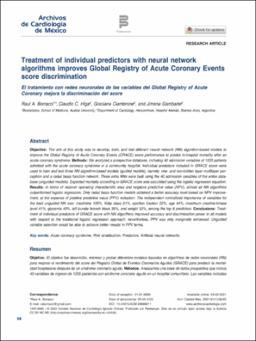| dc.description.abstract | Abstract in English, Spanish
Objective: The aim of this study was to develop, train, and test different neural network (NN) algorithm-based models to improve the Global Registry of Acute Coronary Events (GRACE) score performance to predict in-hospital mortality after an acute coronary syndrome.
Methods: We analyzed a prospective database, including 40 admission variables of 1255 patients admitted with the acute coronary syndrome in a community hospital. Individual predictors included in GRACE score were used to train and test three NN algorithm-based models (guided models), namely: one- and two-hidden layer multilayer perceptron and a radial basis function network. Three extra NNs were built using the 40 admission variables of the entire database (unguided models). Expected mortality according to GRACE score was calculated using the logistic regression equation.
Results: In terms of receiver operating characteristic area and negative predictive value (NPV), almost all NN algorithms outperformed logistic regression. Only radial basis function models obtained a better accuracy level based on NPV improvement, at the expense of positive predictive value (PPV) reduction. The independent normalized importance of variables for the best unguided NN was: creatinine 100%, Killip class 61%, ejection fraction 52%, age 44%, maximum creatine-kinase level 41%, glycemia 40%, left bundle branch block 35%, and weight 33%, among the top 8 predictors.
Conclusions: Treatment of individual predictors of GRACE score with NN algorithms improved accuracy and discrimination power in all models with respect to the traditional logistic regression approach; nevertheless, PPV was only marginally enhanced. Unguided variable selection would be able to achieve better results in PPV terms.
Keywords: Acute coronary syndrome; Artificial neural networks; Estratificación del riesgo; Predictores; Predictors; Redes neuronales artificiales; Risk stratification; Síndrome coronario agudo.
Copyright: © 2021 Permanyer. | es |


